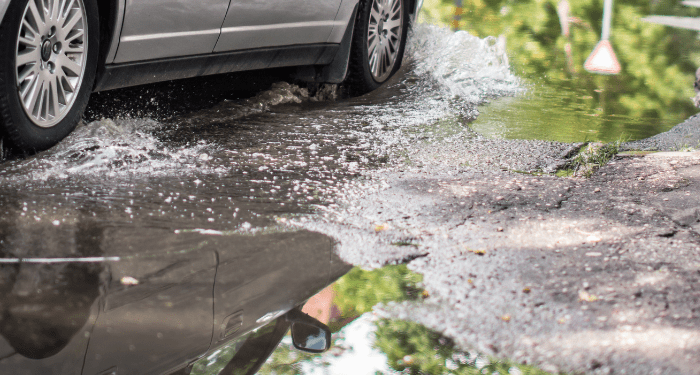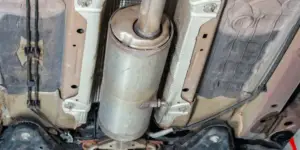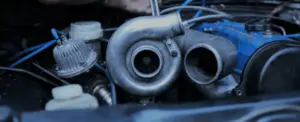Your car’s alternator is used to getting wet. It sits in an exposed position next to the engine and is subjected to mud, heat, cold, and water.
It is usually a temporary occurrence when it gets wet, like when driving through a puddle.
The alternator is always hot, so the heat it generates will dry out any water that finds its way through the vents. You may even see steam coming from it if you pop open the hood.
Gravity will cause most of the water to drip off as well.
The bad news is that if your alternator is completely submerged, it can be damaged beyond repair. Dirt will stick to the alternator’s unprotected brushes, stopping them from working. Again, a car’s alternator can handle light rain and splashes of water, but it will break if your car is submerged in a lot of stagnant flood water.
Are Car Alternators Waterproof?
There is a difference between being able to cope with water and something being classed as waterproof.
Alternators aren’t waterproof, but they are water-resistant.
The alternator is air-cooled, so it requires air vents on the outer casing. Without them, the alternator would overheat despite having a fan to help cool it. If air can get in, so can moisture.
Most alternators have internal voltage regulators, which offer some protection from the rain. A few, though, have external ones at the mercy of splashes and deep puddles.
When voltage regulators get wet and fail, they can stick and allow too much current to the battery and other electrical systems.
Most car manufacturers design their cars, so the alternator sits high enough that it doesn’t get sprayed with water from every puddle you drive through.
Older Chrysler Jeeps are renowned for having the alternator placed low.
Can I Weatherproof My Cars Alternator?
There is no way of completely protecting it from the rain, but you can take steps to limit it.
A splash shield – like a heat shield between the exhaust and underside of the car – will prevent some water from getting to the alternator. You can easily bend a thin piece of sheet metal and fasten it to the chassis.
Perhaps more importantly, it’ll stop mud from blocking the air vents, which is a bigger alternator killer than driving through a puddle of water.
It’s worth remembering that if the airflow is restricted too much, the fan won’t be able to get all the air it needs to keep the alternator cooled.
What Damage Can Be Caused To An Alternator If It Gets Flooded?
Although driving through a puddle will not damage an alternator, severe damage can occur when it’s flooded or completely submerged.
Depending on the style of the alternator, it may short out, but at the very least, the brushes and voltage regulator will fail. Brushes need lubrication, and the floodwater can strip this away, too, causing rust to develop.

Water may also corrode the bearings if not dried out quickly enough.
If the car and alternator are recovered from the flood quickly, they can be dried out. The real problem is that floodwater isn’t clean. It picks up mud, silt, and other debris, depositing it through the vents and deep into the alternator.
It’s the most common cause of the alternator needing to be replaced in flood situations.
Many visitors also read this article: What Is a Hydrolocked Engine? How Much Is The Repair Cost?
Can You Wash The Alternator?
Oil Leak
You can, but it doesn’t make sense unless it is covered in oil from an oil leak. If that’s happened, you’ll need more than just water to remove it.
As the oil will have seeped into the alternator rather than be confined to the outer case, you’ll have to remove it from the car.
The best way is to use a degreaser – depending on the brand; you may have to dilute with water.
Many visitors also read this article: Common Signs Of Oil Leakage In Alternator And How To Fix It
Muddy
The alternator isn’t a visible part, so it doesn’t have to be washed for cosmetic reasons.
It’s far better to clean out the air vent slits with a brush than to wash them. Alternators often fail due to overeating caused by a defective fan or clogged vents.
If you want to wash it, there’s no need to remove it from the car.
Sure, you can do a better job if it’s off, but unless the alternator has stopped working and you’re trying to salvage it, it serves little purpose.
A bucket, sponge, a brush, and water are all you need. Don’t be afraid to give the outside casing a good soak. Wash with the water and sponge to loosen any dirt around the vents. Once it’s been loosened, scrub with the brush until the vents are clean and debris-free.
The dirt will now have turned to mud, so use clean water to wash it away.
Be wary of brake cleaners, as these often contain chlorides that can rust electrical components.
Never use a pressure washer to clean an alternator. Water will find its way into the bearings and the voltage regulator, causing potential terminal damage.
How To Dry An Alternator
Once washed, leave your car parked for twenty-four hours. This will give gravity time to drain any water within the alternator away.
Driving would dry it out quicker. However, you risk dirt and grime from the road sticking to the moisture within the alternator and negating some of the cleaning you’ve just done.
It’s tempting to use compressed air to dry the alternator, but it’s not worth the risk. You could push water deep into the bearings or force it into the voltage regulator. It is better to let it dry naturally.
Can Cleaning An Alternator Make It Work Again?
Sometimes a clean alternator will fail, and one that has never been cleaned will work for many years.
You have very little to lose apart from a couple of hours of your time by trying to clean your alternator in the hope it can be salvaged.
Firstly see if the vents are clogged with debris; if so, clean these thoroughly and see if that fixes it.
If not, you’ll have to remove the alternator and strip it down. Oil may have leaked inside from a clumsy oil change. This could be some time ago, and you weren’t even aware.
If you’re comfortable removing the alternator, I have added a step-by-step video guide of the checks you can do to repair your alternator. This mechanic doesn’t use special tools, and you’ll be able to follow along and clean the parts as you go through it.
In Summary
The alternator’s brass or bronze brushes are coated to prevent wear and electrical arcing. They lose this lubrication if they become wet. The electrical arc then wears out the brushes, which means they need to be replaced.
Your alternator is designed to work still when it’s wet. The heat it generates will soon disperse any moisture.
A submerged alternator risks being contaminated with silt and other debris. This can cause it to fail or rust.
If your alternator is positioned low in the engine bay or you frequently drive on rain-filled potholes, you could consider an alternator splash guard.
An alternator doesn’t need to be removed to be cleaned. A routine inspection to ensure the vents are clear is advised.





![Minor Dry Rotted Tires [GUIDE] Tire-veins-dry-rot](https://carzaza.com/wp-content/uploads/2023/12/Tire-veins-dry-rot-300x150.png)







